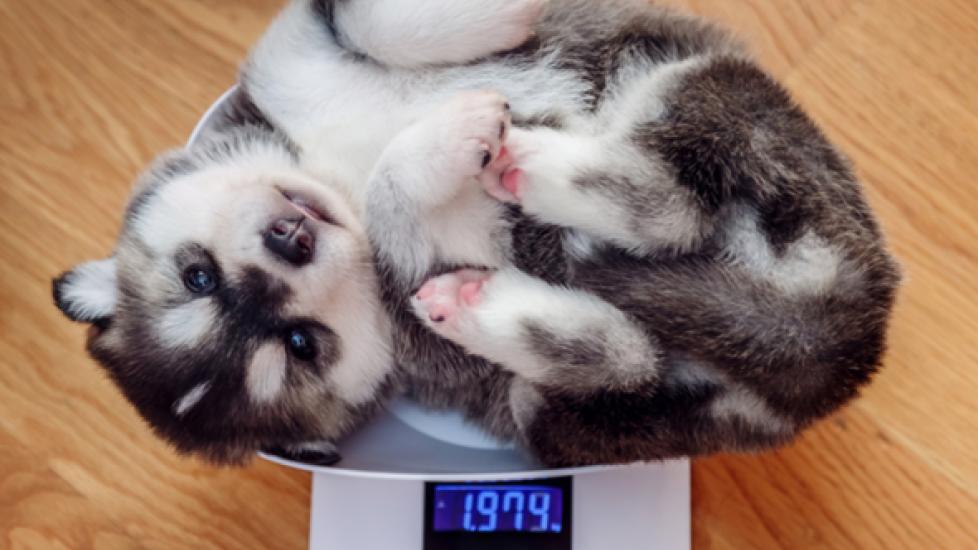How to Weigh Your Dog at Home
By Carol McCarthy
Whether dog or human, most physical exams start with hopping on the scale to be weighed. People rarely like this ritual, but dogs may not mind, especially if the vet rewards them with a treat. Sometimes, however, you might want to weigh your dog at home, between visits to the vet. Find out how—and why—you should weigh your dog at home, below.
How Often Should I Weigh My Dog?
Dr. Susan O’Bell, staff veterinarian at the Massachusetts Society for the Prevention of Cruelty to Animal’s Angell Animal Medical Center in Boston, suggests dogs be weighed at least once a year, while Dr. Matthew Rooney, owner of Aspen Meadow Veterinary Specialists in Longmont, Colo., says most pet parents can be satisfied with weighing their dogs every six months.
In other cases, you might want to weigh your dog more frequently, depending on age and health conditions, they say. “For example, puppies should be weighed far more often, at least every three to four weeks for the first four to six months of life,” O’Bell says. Chronic medical conditions, particularly those that result in changes in appetite or water consumption (such as cancer or diabetes), require more frequent weight checks as well. Your veterinarian can recommend how often your dog should be weighed.
If visits to the vet for weigh-ins are stressful for your dog, difficult for you to schedule or he has a chronic health issue, you can weigh your dog at home. “Many clients ask me if they can use their home scales,” O’Bell says. “I generally tell clients they can use home scales for basic trends, but any major discrepancies should be then confirmed on the hospital scale.”
How Can I Weigh My Dog at Home?
“If your dog is small enough to lift, and you can hold him still for a few seconds at least, then you can weigh him on your bathroom scale,” Rooney says.
If you are using your bathroom scale, place it on a hard and flat surface, preferably the bare floor. The scale works best this way and you eliminate the risk of your dog falling from a high surface, such as a countertop, O’Bell adds. For very small dogs. O’Bell recommends using a baby scale because even a quarter or a half pound of weight loss or gain can be significant when your dog’s total weight is less than ten pounds. If your dog does not like being picked up and held, do not force him to be weighed this way. If he struggles, one or both of you could get hurt.
Rooney suggests using the following process to weigh your dog: First, weigh yourself and record your weight. Then, pick up your dog and step on the scale and record that weight. Subtract your weight from the combined weight of you and your dog to determine his weight.
If you have a very large dog and want to weigh him regularly at home, you can buy a dog scale online or at a large pet-supply store. Prices start at around $100, and models have different weight limits. Additionally, almost any vet clinic will allow you to stop by and weigh your dog for free, Rooney says. Just make sure to always use the same scale. “Scales vary a great degree, so a weight on one scale may differ by five to ten pounds if you use a different scale,” he said.
What if My Dog Doesn’t Like Being Weighed?
The subtle instability of a scale is scary for many dogs (especially larger ones), particularly if they already may be nervous about being in a medical setting, O’Bell says. If possible, begin weighing your dog regularly when he is a puppy and always praise him with your voice and a tasty treat after he has been on the scale, she says.
Regardless of your dog’s age, you can use clicker training as a stress-free way to ease into being weighed. Click and reward him for sniffing the scale, then for placing one foot on it and finally working up to holding a sit or stand on the scale for an accurate weigh-in, O’Bell said. “We always welcome clients to bring their dogs to the hospital for the sole purpose of getting them used to being weighed and/or saying hello to the veterinary staff without any of the more stressful parts of a hospital visit happening that same day,” she says.
Putting your dog on a weight-loss plan? Find out the right way to help your dog lose weight.
